
Project Gutenberg's Gimp Braiding Projects, by Charles E. White, Jr. This eBook is for the use of anyone anywhere in the United States and most other parts of the world at no cost and with almost no restrictions whatsoever. You may copy it, give it away or re-use it under the terms of the Project Gutenberg License included with this eBook or online at www.gutenberg.org. If you are not located in the United States, you'll have to check the laws of the country where you are located before using this ebook. Title: Gimp Braiding Projects Author: Charles E. White, Jr. Release Date: February 1, 2020 [EBook #61293] Language: English Character set encoding: UTF-8 *** START OF THIS PROJECT GUTENBERG EBOOK GIMP BRAIDING PROJECTS *** Produced by Stephen Hutcheson, Lisa Corcoran and the Online Distributed Proofreading Team at http://www.pgdp.net

LANYARDS • LEASHES • BELTS • BRACELETS
Copyright, 1940
by
FELLOWCRAFTERS, INC.
Boston, Massachusetts
PRINTED IN THE UNITED STATES OF AMERICA
For the convenience of craftsmen, we have assembled in this booklet the directions for many of the popular gimp projects, with suggestions for a multitude of patterns which can be made with any desired color combination. These directions have been completely illustrated in color, so that every step can readily be understood, since the true simplicity of braiding has often been obscured by complicated instructions and illustrations.
The material itself is a special coated tape made in various colors and shapes. Standard gimp and Titan lacing are flat and 3/32″ wide. The special ¼″ wide gimp also is flat. Round or cord gimp is available in either 3/64″ or 5/64″ diameters. These various types of gimp can be purchased by the yard, though they are much less expensive when secured by the spool. Leather lacings may be used in place of gimp where particular effects are desired.
Standard and wide gimps have a seam on one face. Always start braiding with this seam next to the core and be careful at the edge of the braid to fold each strand so that the seam remains inside or on the back of the work. Titan lacing is seamless, and therefore can be used with either surface on the outside of the braid. A well-made article, however, should have no twisted strands, whether made of standard gimp, or of seamless Titan lacing.
In all work with gimp it is essential to keep all the strands pulled tight, and to adjust every row of stitches, in order to ensure that the braid will be uniform.
Long working strands may be tied in coils to keep them from snarling. If it is necessary to splice a strand, slice away half the thickness of the gimp on both of the ends to be joined. Overlap the two ends and lead them through several stitches, then trim off the extra material. (Fig. 1.) If it is necessary to set the braid aside before it is finished, use ordinary paper clips or knot the strands to keep them in place.
The type of core most widely used for bracelet making is formed from a strip of spring steel either ½″ or ¼″ wide. Make a narrow V-shaped slit half the width of the band at about ½″ from one end. (Fig. 2A.) Mark off beyond this cut the circumference of your bracelet (usually 8-9 inches) and make another slit half way through from the opposite side. Clip off the metal about ½″ beyond this second slit. Connect the band as shown, with the ends on the inside of the bracelet. (Figs. 3 and 4.) Set the band on a solid surface and pound with a mallet or hammer until the edges fit smoothly.

Fig. 1

Fig. 2

Fig. 3

Fig. 4


The recently developed basket-weave bracelets are among the easiest and most popular projects for flat gimp. This is in part due to the fact that they offer so many possibilities for originality of design. The standard gimp types, for instance, may be made with from one to seven colors, so it is possible to match them with any color schemes of belts or leashes, or to make them harmonize with any costume.
Fasten the ends of the short strands to the band with a paper clip in the position shown in figure 5. Leaving one half inch or so free at the start, weave the long strand under one—over one—under one. (Fig. 6.) Bring it around through the band and weave the next row of stitches over one—under on—over one. (Fig. 7.) Pull the strands tight.

Fig. 5

Fig. 6

Fig. 7
Continue alternating these two steps all the way around the band. If the pattern does not come out even, rip out the last few stitches and weave them again closer together to gain space for the extra stitch. Then remove the paper clip and weave each short strand back loosely through the first two stitches at the beginning. (Fig. 8.) Cut off the beginning end of the weaving strand at the edge of the bracelet. (Fig. 9.)
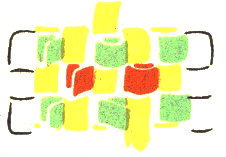
Fig. 8

Fig. 9
Finish off by braiding along the start of the weaving strand (Fig. 10), around the outside of the band. This makes the last weaving row under one—over one—under one. Pull all the ends tight and clip them off close to the braid.

Fig. 10
The pattern shown above is made with three colors according to the direction illustrations. Checkerboard patterns are made by using one color on the band and a second color for weaving. Four more two-color patterns are made by placing the lighter color at the center of the band or at the edge, and by using a dark or a light weaving strand. Three-color patterns have six additional possibilities for variation on the same principle.


Fasten the five short strands to the band as shown in figure 12. Then weave across the band in any of the ways shown below, bringing the strand through the center after each row. (Fig. 13.) Several two-color combinations of these stitches are suggested here, but do not let these limit your originality, as there are very many possible patterns. Finish off the bracelet as described on page 2.

Fig. 12

Fig. 13
Made in exactly the same way as the preceding. The beginning strands may be tied in place or fastened with adhesive tape.
The directions already given apply equally well to all of the following projects. Six-strand standard gimp bracelets are made like five-strand bracelets with an additional 12″ strand on the core. Wood core napkin rings like that shown above require three, four, or five 8″ core strands and a 3 yd. weaving strand. Napkin rings made on shortened ¼″ bands (6″ between the notches) require either five or six 8″ standard gimp core strands and a 2¼ yd. weaving strand. Narrow band bracelets of the type shown at the top of the page can be made of standard gimp with three or four 12″ core strands and a 2¼ yd. weaving strand. Narrow band napkin rings require three or four 8″ core strands and a 1¾ yd. weaving strand.

{Two-color combinations}

The stout core necessary for a dog leash may be made of standard core braid or of extra heavy twine. Fold one end back to make a loop 7″ long. Bind the end with wire. Put the other end through the eye of the snap, then bend it back and bind it with wire to make a loop 1½″ long. (Fig. 14.)

Fig. 14
Tie the center of the strands to the center of the core with one end of a piece of cord. Tie the other end of the cord to any firm object so that you can keep the leash pulled tight while you are braiding. Arrange the strands as in figure 15.

Fig. 15
Braid toward one end as follows: Bring the upper right strand around the back, forward between the left strands, and across the core to lie parallel to the other right strand. In successive steps, merely take the uppermost strand—left or right as the case may be—around the back, between the strands of the opposite side, and across the front. Keep the stitches pushed tightly together to achieve a uniform result. (Figs. 16 and 17.)

Fig. 16

Fig. 17
Continue around the loop until you come back to the main braid. Then make a square as follows: Holding the braid as in figure 18, cross the two rear strands. (Fig. 19.) Bring the rear right strand down over the forward right strand. (Fig. 20.) Loop the latter over the first strand and bring it down between the other two strands. (Fig. 21.) Loop the third strand similarly over all the strands and bring it down in back. (Fig. 22.) Bring the fourth strand over the third and through the loop of the first. (Fig. 23.) Pull the strands tight (Fig. 24) so that the top appears as a square.

Fig. 18

Fig. 19

Fig. 20

Fig. 21

Fig. 22
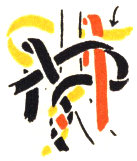
Fig. 23

Fig. 24
Then make a square braid. Fold one strand back on itself. (Fig. 25.) Fold the next strand (Fig. 26) back on itself over the first one. Fold the third strand over the second. (Fig. 27.) Fold the last strand over the third and through the loop of the first. (Fig. 28.)

Fig. 25

Fig. 26

Fig. 27
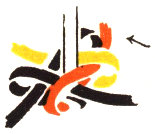
Fig. 28
Complete the stitch by drawing all the strands tight. Continue making squares in this way until the strands are only about 2½″ long. The spiral braiding described on page 6 may be used in place of this square braiding or in combination with it.
End the braid with a lock knot by looping each strand under the loose end of the overlying strand and through the top stitch as shown in figures 29-32. Pull the ends tight, making certain as you do so that none of the strands appear twisted. Then clip off the ends of the strands. (Fig. 33.)

Fig. 29

Fig. 30

Fig. 31

Fig. 32

Fig. 33
Follow the same steps in making the other half of the leash.
Spiral braiding may be substituted after the first square. This is made in exactly the same way as square braiding except that each strand is bent over the top of the braid on the opposite side of the core, rather than back along itself. (Figs. 34-38.)

Fig. 34

Fig. 35

Fig. 36
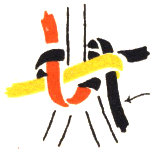
Fig. 37

Fig. 38
After completing the loops at the ends, many craftsmen prefer to make several more ordinary stitches before starting the squares.
Six-strand round braiding can also be used for leashes. It is made in much the same way, except that the top strand is brought around the back, then forward below the first strand, over the second strand, and under the third strand. (Fig. 39.) When in doubt about the order of the strands, remember to weave the top strand so that it passes over the front strand on the opposite side. You can see this clearly in figure 39.

Fig. 39
When making the square braiding, lay an opposite pair of strands along the core and weave the remaining four as described above. The strands on the core may be clipped with the others after making the lock knot.
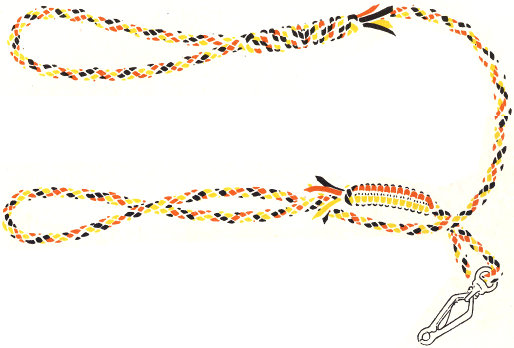

Lanyards are made in much the same way as leashes, but without the core. The snap is fastened securely so that the work can be pulled against it. Then both strands are run half way through the ring to give four equal braiding strands. Cross the strands on the ring in exactly the way shown in figure 40. This arrangement corresponds to the starting position of the leash. The braiding is done in the same way as that described for the leash, beginning with the upper right strand. (Fig. 16.)
When only one foot of lacing is left, form the loop of the lanyard by folding the braid back as in figure 41. Cross the two lower strands behind the main braid (Fig. 42), and finish with the square or spiral braid and the lock knot as described for the leash. If you wish the square braid to slip along the lanyard, braid it loosely.
The alternative pattern shown is made by arranging the strands at the start as in figure 43.

Fig. 40

Fig. 41

Fig. 42

Fig. 43
This is made in the same way as the six-strand leash by starting as follows: The rear left strand is brought around its forward part and bent to the right. (Fig. 44.) Both parts of the middle strand are brought to the right. (Fig. 45.) The forward part of the right strand is woven to the left over one—under one—over one, and the rear part of the same strand is woven over two—under one. Start braiding with the upper right strand.

Fig. 44

Fig. 45
Unusual and very attractive results can be obtained by utilizing round gimp in making these projects. Leashes and lanyards, for instance, of either the six- or four-strand type are very smart when made with small round gimp. The larger cord gimp is suitable for four- or six-strand leashes and for four-strand lanyards. Some of these possibilities are illustrated on this page. The amount of material required is the same as for the standard gimp projects and the method of working is identical. It is advisable, however, to use picture wire as a core for the leashes. When making articles of large round gimp, it will also be found more satisfactory to use spiral braiding in place of the square braiding.
Heavy leashes for large dogs can be made of wide gimp braided over a stout rope core.

These illustrated bracelets need no introduction, since they are standard as braiding projects. They are ordinarily made with from one to four colors, but can be made with as many as eight colors, so there is a wide range of possibilities for bright patterns. The braid itself is an eight strand variation of the braiding used for leashes and lanyards.
Hold the center of all four strands against the inside of the band about ½″ beyond the joint. (Fig. 46.) If standard gimp is used, be sure to have the seams next to the metal. Fold the strands on the left diagonally down across the band, holding them with the thumb and forefinger of the left hand. (Fig. 47.)

Fig. 46

Fig. 47
Weave the top right strand across the band under the first, over the second, under the third, and over the fourth strands. (Fig. 48.) Weave the next strand over the first, under the second, over the third, and under the fourth strands. (Fig. 49.) Weave the third strand under one—over one—under one—over one, and weave the last strand under two—over one—under one. Make certain that none of the strands are twisted, then tighten the braid on the band until the gimp lies flat without bulging. (Fig. 50.)

Fig. 48

Fig. 49

Fig. 50
Pass the top right strand through the bracelet. Bring it forward between the two middle strands at the left. Then fold it back across the band over the third strand and under the fourth. (Fig. 51.) Pull it tight. Next do the same with the upper left strand (Fig. 52), and continue alternately weaving the top left and right strands in this way. The last strand woven shows as the lowest on the inside, so you can always tell which strand to weave next.

Fig. 51

Fig. 52
If the pattern does not come out even when you have woven the entire distance around the bracelet, ease the braid back around the band to gain whatever additional space you need in order to complete the design.
Clip the ends of the strands to make them pointed. Then weave the lower right strand under the beginning strand on the same side. (Fig. 53.) Weave the lower left strand over the first and under the second beginning strands on the left. (Fig. 54.) Then weave the free strand on the left over one—under one, thus completing the face of the braid with all the strands woven to the edge. (Fig. 55.)

Fig. 53

Fig. 54

Fig. 55
To finish off, work inside the bracelet. Weave the upper left strand under the first two slanting strands on the right. (Fig. 56.) Weave the upper right strand under the two opposite strands. (Fig. 57.)

Fig. 56

Fig. 57
Weave the rest of the strands in the same way (Fig. 58), then draw the work tight and trim off the ends.
Many additional patterns can be made by varying the position of the strands at the start. The strands may simply be crossed on the inside (Fig. 59), to make one series of patterns. They may be looped to bring both ends of the same strand on the same side for another group of patterns. Titan lacing may be looped flat as in figure 60, but standard gimp should have the strands arranged as in figure 61 so that the seam sides will be toward the band. Combinations of straight, crossed, and looped strands offer further possibilities for patterns.

Fig. 58

Fig. 59

Fig. 60
Eight separate strands 4 ft. long may be started as shown in figure 62. An ordinary paper clip is sufficient to hold the braid in place. Weaving with eight strands extends the possibilities for unusual patterns, but care must be exercised to keep the designs simple.

Fig. 61

Fig. 62
The stunning bracelets of the type shown here are made in exactly the same way as the standard bracelets.
These, also, are made in the same way as the standard bracelets, offering the same opportunities for patterns.
The preceding bracelets can be made equally well with three long strands instead of four. The only difference in the braiding is that the strand which is carried around the back should be brought forward between the first two strands and woven across the band over one—under one. (Fig. 63.) The lengths of the strands required are as follows:

Fig. 63
Any of the above can be made as napkin rings. If the core used is 6″ in circumference (in metal bands, 6″ between the notches), use three-fourths as much material as is required for the corresponding bracelet.


These bracelets are typical of the colorful possibilities of the new round gimp. Both are made entirely of gimp without any special accessories, and require very little time for the braiding.
Make a double coil of wide gimp of whatever diameter is desired. Cut both ends on the same slant, so that there will always be only two thicknesses of material in the finished core. (Fig. 64.)

Fig. 64
Tie the two strands of cord gimp together at one end, leaving about 1″ beyond the knot to use later for finishing. Place the knot at the left side of the core. Select the color which is to show on the band and lead it across the outside of the core. (Fig. 65.) Lead the other strand through the core, cross it over the top strand (Fig. 66), lead it back under the core and up through the loop at the left side. (Fig. 67.) This process makes half a square knot.

Fig. 65

Fig. 66
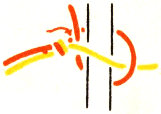
Fig. 67
In all succeeding knots, merely choose the color which is to show on the band and lead it across in front. (Fig. 68.) Then loop the other strand over it, around the back, and forward through the loop on the opposite side. (Fig. 69.)
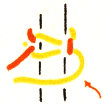
Fig. 68

Fig. 69
When you have gone completely around the bracelet, untie the starting knot and tuck in the loose ends.
All the patterns shown above are made in exactly this way. The core may either be of the same color as one of the working strands, or of a third color to add little decorative touches between the stitches.
Cross the strands at their midpoints. (Fig. 70.) Bring the right under strand around over the next two strands and down behind. (Fig. 71.) Do the same with the second strand. (Fig. 72.) Bring the third strand around and down through the loop of the first. (Fig. 73.) Bring the last strand around and down through both the first and second loops. (Fig. 74.) Insert the core through the middle so that about 1″ is beyond the knot. Then pull all the strands tight. (Fig. 75.)

Fig. 70

Fig. 71

Fig. 72

Fig. 73

Fig. 74

Fig. 75
Continue braiding for about 8″ in this same way. Then fit the braid around your wrist to find the bracelet size needed. Cut the long end of the core so that it just touches the beginning of the braid. (Fig. 76.) Overlap the two ends of the core, and complete the braid over the doubled strand. Tuck the loose ends through the beginning stitches and trim them off close to the braid.

Fig. 76
Belts to match bracelets and leashes or to harmonize with various costumes are favorite gimp projects. They may be made from any type of gimp. The popular twelve-strand braids can have as many as six colors, if so desired.
The choice of the buckle is quite important. Standard buckles with tongues are the most widely used. Special decorative effects can be achieved with tongueless buckles. Other attractive results can be produced by covering the buckle with gimp, using half hitches (Fig. 77) or basket stitches as shown in figure 78.

Fig. 77
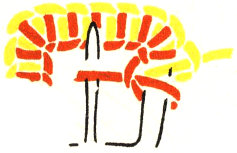
Fig. 78
Fasten the buckle securely so that you can pull against it to keep the braiding tight. Hang three strands of gimp on each side of the tongue, so that you have twelve strands of equal length. Since the order of the strands determines the pattern, arrange the strands on the buckle as indicated for any of the patterns on page 11.
Bring the back part of the left strand forward and bend it across the other section of the same strand right side up. (Fig. 79.) Bring the lower part of the second strand forward and weave it over the front portion and under the forward part of the left strand. (Fig. 80.) In the same way bring each strand around to the front and weave it to the left over one—under one—over one—etc. When the work appears as in figure 81, check the strands to see that they are all right side up before beginning to braid.

Fig. 79

Fig. 80

Fig. 81
Take the upper right strand and weave it across over one—under one—etc. (Fig. 82.) Then weave the upper left strand under one—over one—under one—etc. (Fig. 83) Bend the strands at the edge as in figure 84. If Titan lacing is used, the strands may be folded at the edge instead as in figure 85. Continue weaving the right and left strands in this way.

Fig. 82

Fig. 83

Fig. 84

Fig. 85
When you have woven the full length you need for the belt, make the last row from left to right and fasten the strands with a paper clip as shown in figure 86. Turn the belt around and weave each strand loosely back along itself. (Figs. 87 and 88.) Pull the strands tight, then trim the ends close to the braid.

Fig. 86
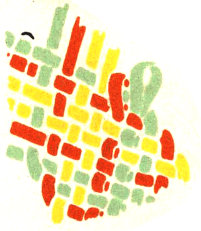
Fig. 87

Fig. 88
Make the loop of simple three strand braiding sewed at the ends and sewed to the belt 1″ below the buckle.
Little need be said of the color patterns shown on page 11. At one end of each we have indicated the positions of the strands on the buckle.
These same directions can be followed for belts with any number of strands looped through a buckle. One of the most effective of these variations can be made with wide gimp. This belt, as made ten strands wide and a yard long calls for a 1¾″ buckle and five weaving strands, 3½ yds. each.

Although there are several qualities of gimp lacing on the market, only the highest grade is fit for use in craft work. The gimp we carry is made to order under our own strict specifications. It is waterproof, and therefore washable. It has unusual tensile strength and will withstand much abuse. The large amount we now sell makes it possible to offer this improved gimp at lower prices.

GL-1 STANDARD GIMP—3/32″ wide. Flat, seamless, lustrous, washable. Colors: gold, silver, white, red, orange, yellow, blue, tan, brown, black, and green. yd. $.02; 50 yds. $.85; 100 yds. $1.50 500 or more yds. $1.35 per 100 yds.
GL-3 TITAN LACING—3/32″ wide. Colors: red, orange, yellow, green, blue, tan, brown, black, white, gold, and silver. Extra strong. Has half-oval cross-section. yd. $.02; 50 yds. $.85; 100 yds. $1.50
LL-1 GOAT LEATHER LACING—3/32″ wide. Colors: natural, red, green, blue, brown, and black. yd. $.06; 50 yds. $2.50; 100 yds. $4.75
LL-3 SPECIAL GOAT LACING—5/64″ wide—tan only. yd. $.04; 50 yds. $1.75; 100 yds. $3.00
GL-4 WIDE GIMP—¼″ wide. Colors: red, green, navy blue, brown, white, and black. yd. $.05; 100 yds. $3.75 Gold or silver yd. $.10; 100 yds. $7.50
GL-5 ROUND GIMP No. 3—Colors: red, orange, yellow, green, light and medium blue, black, brown, white, gold, gray, and silver yd. $.02: 50 yds. $.85; 100 yds. $1.50
GL-6 EXTRA HEAVY ROUND GIMP No. 5—Colors: red, yellow, green, blue, brown, white, gray, and black yd. $.035; 50 yds. $1.60; 100 yds. $3.00
CORE BRAID—for leashes yd. $.03; 50 yds. $1.35; 100 yds. $2.25
WIRE CORE—for leashes yd. $.02; 50 yds. $.85
STEEL BRACELET BANDS—These steel bands are tempered to the proper hardness to have an excellent springiness. ½″ wide ea. $.04; doz. $.40 ¾″ wide ea. $.05; doz. $.50
WOODEN BRACELET CORES—light blanks made of hard wood, attractively rounded on the outer surface. ea. $.15; doz. $1.50
WOODEN NAPKIN RING CORES ea. $.10; doz. $1.00
CENTRAL BAR NICKEL BUCKLES ea. $.10; doz. $1.10
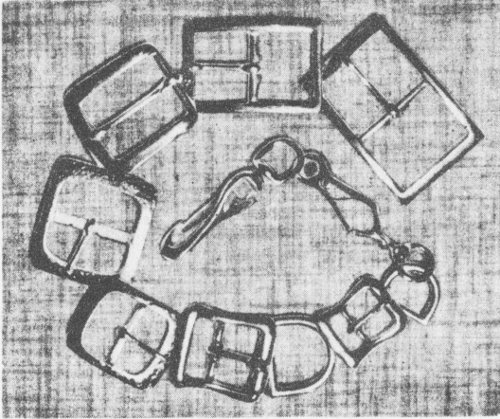
STANDARD BELT BUCKLES—brass or nickel finish for belt widths of 1″ (the size recommended for the standard 12-strand belt). 1¼″, and 1½″ ea. $.07; doz. $.77
SMALL BUCKLES—assorted sizes and shapes ea. $.05; doz. $.55
GT-16 FID $.35
LANYARD OR WATCH-GUARD SNAPS—bright brass nickel finish ea. $.05; doz. $.50 ea. $.06; doz. $.60
DOG LEASH SNAPS—standard type with swivel ea. $.06; doz. $.66
FRENCH DOG LEASH SNAPS ea. $.15; doz. $1.65
DOG COLLAR BUCKLE AND “D” ea. $.15; doz. $1.65
At the head of the instructions for each type of project will be found a list of necessary materials. Many of these lists prescribe lengths of gimp in fractions of yards.
In ordering, order to the nearest full yard, as we do not fill orders for fractional yards of gimp.
Great savings are effected by purchasing gimp in 50 or 100 yard spools and cutting for yourself the required lengths for gimp projects.
BRAIDING AND KNOTTING by C. A. Belash—This Beacon Handicraft Series text book is proving very popular. It gives explicit directions for all types of braiding and knotting with both gimp and cord, and it contains complete directions for making many attractive articles. Clothbound, with about 200 illustrations grouped on more than 50 plates $1.00
SQUARE KNOTTING by P. C. Herwig—These illustrated booklets contain full instructions and suggestions for popular projects No. 1 $.15; No. 2 $.25; No. 3 $1.00
Shipping charges are to be paid by the buyer. All prices subject to change without notice.
Materials and suggestions for other crafts are contained in our sixth catalogue. This catalogue will be sent to you on receipt of 25c (rebatable).
LEATHERCRAFT • GLOVE MAKING • BIRCHCRAFT • PERMATEX • GIMP BRAIDING • KNOTTING • FIBRE CRAFT • WEAVING • BEADCRAFT • AMBEROLCRAFT • METALCRAFT • METAL EMBOSSING • METAL SCROLLWORK • METAL ETCHING • BLOCK PRINTING • PLYWOOD CARVING • CHIP CARVING • WOOD CARVING • WOODWORKING • BANTAM WEIGHT BOATS • MODEL AIRPLANES • MODEL YACHTS • GLASS ETCHING • ART VENEERCRAFT • POTTERY
Send 25c (rebatable) for our catalogue of suggestions, materials, supplies, and tools for craft groups and individual craftsmen.
Fellowcrafters
Incorporated
General Office Mail Order Department Retail Store
64 STANHOPE STREET, BOSTON, MASS.
End of Project Gutenberg's Gimp Braiding Projects, by Charles E. White, Jr.
*** END OF THIS PROJECT GUTENBERG EBOOK GIMP BRAIDING PROJECTS ***
***** This file should be named 61293-h.htm or 61293-h.zip *****
This and all associated files of various formats will be found in:
http://www.gutenberg.org/6/1/2/9/61293/
Produced by Stephen Hutcheson, Lisa Corcoran and the Online
Distributed Proofreading Team at http://www.pgdp.net
Updated editions will replace the previous one--the old editions will
be renamed.
Creating the works from print editions not protected by U.S. copyright
law means that no one owns a United States copyright in these works,
so the Foundation (and you!) can copy and distribute it in the United
States without permission and without paying copyright
royalties. Special rules, set forth in the General Terms of Use part
of this license, apply to copying and distributing Project
Gutenberg-tm electronic works to protect the PROJECT GUTENBERG-tm
concept and trademark. Project Gutenberg is a registered trademark,
and may not be used if you charge for the eBooks, unless you receive
specific permission. If you do not charge anything for copies of this
eBook, complying with the rules is very easy. You may use this eBook
for nearly any purpose such as creation of derivative works, reports,
performances and research. They may be modified and printed and given
away--you may do practically ANYTHING in the United States with eBooks
not protected by U.S. copyright law. Redistribution is subject to the
trademark license, especially commercial redistribution.
START: FULL LICENSE
THE FULL PROJECT GUTENBERG LICENSE
PLEASE READ THIS BEFORE YOU DISTRIBUTE OR USE THIS WORK
To protect the Project Gutenberg-tm mission of promoting the free
distribution of electronic works, by using or distributing this work
(or any other work associated in any way with the phrase "Project
Gutenberg"), you agree to comply with all the terms of the Full
Project Gutenberg-tm License available with this file or online at
www.gutenberg.org/license.
Section 1. General Terms of Use and Redistributing Project
Gutenberg-tm electronic works
1.A. By reading or using any part of this Project Gutenberg-tm
electronic work, you indicate that you have read, understand, agree to
and accept all the terms of this license and intellectual property
(trademark/copyright) agreement. If you do not agree to abide by all
the terms of this agreement, you must cease using and return or
destroy all copies of Project Gutenberg-tm electronic works in your
possession. If you paid a fee for obtaining a copy of or access to a
Project Gutenberg-tm electronic work and you do not agree to be bound
by the terms of this agreement, you may obtain a refund from the
person or entity to whom you paid the fee as set forth in paragraph
1.E.8.
1.B. "Project Gutenberg" is a registered trademark. It may only be
used on or associated in any way with an electronic work by people who
agree to be bound by the terms of this agreement. There are a few
things that you can do with most Project Gutenberg-tm electronic works
even without complying with the full terms of this agreement. See
paragraph 1.C below. There are a lot of things you can do with Project
Gutenberg-tm electronic works if you follow the terms of this
agreement and help preserve free future access to Project Gutenberg-tm
electronic works. See paragraph 1.E below.
1.C. The Project Gutenberg Literary Archive Foundation ("the
Foundation" or PGLAF), owns a compilation copyright in the collection
of Project Gutenberg-tm electronic works. Nearly all the individual
works in the collection are in the public domain in the United
States. If an individual work is unprotected by copyright law in the
United States and you are located in the United States, we do not
claim a right to prevent you from copying, distributing, performing,
displaying or creating derivative works based on the work as long as
all references to Project Gutenberg are removed. Of course, we hope
that you will support the Project Gutenberg-tm mission of promoting
free access to electronic works by freely sharing Project Gutenberg-tm
works in compliance with the terms of this agreement for keeping the
Project Gutenberg-tm name associated with the work. You can easily
comply with the terms of this agreement by keeping this work in the
same format with its attached full Project Gutenberg-tm License when
you share it without charge with others.
1.D. The copyright laws of the place where you are located also govern
what you can do with this work. Copyright laws in most countries are
in a constant state of change. If you are outside the United States,
check the laws of your country in addition to the terms of this
agreement before downloading, copying, displaying, performing,
distributing or creating derivative works based on this work or any
other Project Gutenberg-tm work. The Foundation makes no
representations concerning the copyright status of any work in any
country outside the United States.
1.E. Unless you have removed all references to Project Gutenberg:
1.E.1. The following sentence, with active links to, or other
immediate access to, the full Project Gutenberg-tm License must appear
prominently whenever any copy of a Project Gutenberg-tm work (any work
on which the phrase "Project Gutenberg" appears, or with which the
phrase "Project Gutenberg" is associated) is accessed, displayed,
performed, viewed, copied or distributed:
This eBook is for the use of anyone anywhere in the United States and
most other parts of the world at no cost and with almost no
restrictions whatsoever. You may copy it, give it away or re-use it
under the terms of the Project Gutenberg License included with this
eBook or online at www.gutenberg.org. If you are not located in the
United States, you'll have to check the laws of the country where you
are located before using this ebook.
1.E.2. If an individual Project Gutenberg-tm electronic work is
derived from texts not protected by U.S. copyright law (does not
contain a notice indicating that it is posted with permission of the
copyright holder), the work can be copied and distributed to anyone in
the United States without paying any fees or charges. If you are
redistributing or providing access to a work with the phrase "Project
Gutenberg" associated with or appearing on the work, you must comply
either with the requirements of paragraphs 1.E.1 through 1.E.7 or
obtain permission for the use of the work and the Project Gutenberg-tm
trademark as set forth in paragraphs 1.E.8 or 1.E.9.
1.E.3. If an individual Project Gutenberg-tm electronic work is posted
with the permission of the copyright holder, your use and distribution
must comply with both paragraphs 1.E.1 through 1.E.7 and any
additional terms imposed by the copyright holder. Additional terms
will be linked to the Project Gutenberg-tm License for all works
posted with the permission of the copyright holder found at the
beginning of this work.
1.E.4. Do not unlink or detach or remove the full Project Gutenberg-tm
License terms from this work, or any files containing a part of this
work or any other work associated with Project Gutenberg-tm.
1.E.5. Do not copy, display, perform, distribute or redistribute this
electronic work, or any part of this electronic work, without
prominently displaying the sentence set forth in paragraph 1.E.1 with
active links or immediate access to the full terms of the Project
Gutenberg-tm License.
1.E.6. You may convert to and distribute this work in any binary,
compressed, marked up, nonproprietary or proprietary form, including
any word processing or hypertext form. However, if you provide access
to or distribute copies of a Project Gutenberg-tm work in a format
other than "Plain Vanilla ASCII" or other format used in the official
version posted on the official Project Gutenberg-tm web site
(www.gutenberg.org), you must, at no additional cost, fee or expense
to the user, provide a copy, a means of exporting a copy, or a means
of obtaining a copy upon request, of the work in its original "Plain
Vanilla ASCII" or other form. Any alternate format must include the
full Project Gutenberg-tm License as specified in paragraph 1.E.1.
1.E.7. Do not charge a fee for access to, viewing, displaying,
performing, copying or distributing any Project Gutenberg-tm works
unless you comply with paragraph 1.E.8 or 1.E.9.
1.E.8. You may charge a reasonable fee for copies of or providing
access to or distributing Project Gutenberg-tm electronic works
provided that
* You pay a royalty fee of 20% of the gross profits you derive from
the use of Project Gutenberg-tm works calculated using the method
you already use to calculate your applicable taxes. The fee is owed
to the owner of the Project Gutenberg-tm trademark, but he has
agreed to donate royalties under this paragraph to the Project
Gutenberg Literary Archive Foundation. Royalty payments must be paid
within 60 days following each date on which you prepare (or are
legally required to prepare) your periodic tax returns. Royalty
payments should be clearly marked as such and sent to the Project
Gutenberg Literary Archive Foundation at the address specified in
Section 4, "Information about donations to the Project Gutenberg
Literary Archive Foundation."
* You provide a full refund of any money paid by a user who notifies
you in writing (or by e-mail) within 30 days of receipt that s/he
does not agree to the terms of the full Project Gutenberg-tm
License. You must require such a user to return or destroy all
copies of the works possessed in a physical medium and discontinue
all use of and all access to other copies of Project Gutenberg-tm
works.
* You provide, in accordance with paragraph 1.F.3, a full refund of
any money paid for a work or a replacement copy, if a defect in the
electronic work is discovered and reported to you within 90 days of
receipt of the work.
* You comply with all other terms of this agreement for free
distribution of Project Gutenberg-tm works.
1.E.9. If you wish to charge a fee or distribute a Project
Gutenberg-tm electronic work or group of works on different terms than
are set forth in this agreement, you must obtain permission in writing
from both the Project Gutenberg Literary Archive Foundation and The
Project Gutenberg Trademark LLC, the owner of the Project Gutenberg-tm
trademark. Contact the Foundation as set forth in Section 3 below.
1.F.
1.F.1. Project Gutenberg volunteers and employees expend considerable
effort to identify, do copyright research on, transcribe and proofread
works not protected by U.S. copyright law in creating the Project
Gutenberg-tm collection. Despite these efforts, Project Gutenberg-tm
electronic works, and the medium on which they may be stored, may
contain "Defects," such as, but not limited to, incomplete, inaccurate
or corrupt data, transcription errors, a copyright or other
intellectual property infringement, a defective or damaged disk or
other medium, a computer virus, or computer codes that damage or
cannot be read by your equipment.
1.F.2. LIMITED WARRANTY, DISCLAIMER OF DAMAGES - Except for the "Right
of Replacement or Refund" described in paragraph 1.F.3, the Project
Gutenberg Literary Archive Foundation, the owner of the Project
Gutenberg-tm trademark, and any other party distributing a Project
Gutenberg-tm electronic work under this agreement, disclaim all
liability to you for damages, costs and expenses, including legal
fees. YOU AGREE THAT YOU HAVE NO REMEDIES FOR NEGLIGENCE, STRICT
LIABILITY, BREACH OF WARRANTY OR BREACH OF CONTRACT EXCEPT THOSE
PROVIDED IN PARAGRAPH 1.F.3. YOU AGREE THAT THE FOUNDATION, THE
TRADEMARK OWNER, AND ANY DISTRIBUTOR UNDER THIS AGREEMENT WILL NOT BE
LIABLE TO YOU FOR ACTUAL, DIRECT, INDIRECT, CONSEQUENTIAL, PUNITIVE OR
INCIDENTAL DAMAGES EVEN IF YOU GIVE NOTICE OF THE POSSIBILITY OF SUCH
DAMAGE.
1.F.3. LIMITED RIGHT OF REPLACEMENT OR REFUND - If you discover a
defect in this electronic work within 90 days of receiving it, you can
receive a refund of the money (if any) you paid for it by sending a
written explanation to the person you received the work from. If you
received the work on a physical medium, you must return the medium
with your written explanation. The person or entity that provided you
with the defective work may elect to provide a replacement copy in
lieu of a refund. If you received the work electronically, the person
or entity providing it to you may choose to give you a second
opportunity to receive the work electronically in lieu of a refund. If
the second copy is also defective, you may demand a refund in writing
without further opportunities to fix the problem.
1.F.4. Except for the limited right of replacement or refund set forth
in paragraph 1.F.3, this work is provided to you 'AS-IS', WITH NO
OTHER WARRANTIES OF ANY KIND, EXPRESS OR IMPLIED, INCLUDING BUT NOT
LIMITED TO WARRANTIES OF MERCHANTABILITY OR FITNESS FOR ANY PURPOSE.
1.F.5. Some states do not allow disclaimers of certain implied
warranties or the exclusion or limitation of certain types of
damages. If any disclaimer or limitation set forth in this agreement
violates the law of the state applicable to this agreement, the
agreement shall be interpreted to make the maximum disclaimer or
limitation permitted by the applicable state law. The invalidity or
unenforceability of any provision of this agreement shall not void the
remaining provisions.
1.F.6. INDEMNITY - You agree to indemnify and hold the Foundation, the
trademark owner, any agent or employee of the Foundation, anyone
providing copies of Project Gutenberg-tm electronic works in
accordance with this agreement, and any volunteers associated with the
production, promotion and distribution of Project Gutenberg-tm
electronic works, harmless from all liability, costs and expenses,
including legal fees, that arise directly or indirectly from any of
the following which you do or cause to occur: (a) distribution of this
or any Project Gutenberg-tm work, (b) alteration, modification, or
additions or deletions to any Project Gutenberg-tm work, and (c) any
Defect you cause.
Section 2. Information about the Mission of Project Gutenberg-tm
Project Gutenberg-tm is synonymous with the free distribution of
electronic works in formats readable by the widest variety of
computers including obsolete, old, middle-aged and new computers. It
exists because of the efforts of hundreds of volunteers and donations
from people in all walks of life.
Volunteers and financial support to provide volunteers with the
assistance they need are critical to reaching Project Gutenberg-tm's
goals and ensuring that the Project Gutenberg-tm collection will
remain freely available for generations to come. In 2001, the Project
Gutenberg Literary Archive Foundation was created to provide a secure
and permanent future for Project Gutenberg-tm and future
generations. To learn more about the Project Gutenberg Literary
Archive Foundation and how your efforts and donations can help, see
Sections 3 and 4 and the Foundation information page at
www.gutenberg.org
Section 3. Information about the Project Gutenberg Literary Archive Foundation
The Project Gutenberg Literary Archive Foundation is a non profit
501(c)(3) educational corporation organized under the laws of the
state of Mississippi and granted tax exempt status by the Internal
Revenue Service. The Foundation's EIN or federal tax identification
number is 64-6221541. Contributions to the Project Gutenberg Literary
Archive Foundation are tax deductible to the full extent permitted by
U.S. federal laws and your state's laws.
The Foundation's principal office is in Fairbanks, Alaska, with the
mailing address: PO Box 750175, Fairbanks, AK 99775, but its
volunteers and employees are scattered throughout numerous
locations. Its business office is located at 809 North 1500 West, Salt
Lake City, UT 84116, (801) 596-1887. Email contact links and up to
date contact information can be found at the Foundation's web site and
official page at www.gutenberg.org/contact
For additional contact information:
Dr. Gregory B. Newby
Chief Executive and Director
[email protected]
Section 4. Information about Donations to the Project Gutenberg
Literary Archive Foundation
Project Gutenberg-tm depends upon and cannot survive without wide
spread public support and donations to carry out its mission of
increasing the number of public domain and licensed works that can be
freely distributed in machine readable form accessible by the widest
array of equipment including outdated equipment. Many small donations
($1 to $5,000) are particularly important to maintaining tax exempt
status with the IRS.
The Foundation is committed to complying with the laws regulating
charities and charitable donations in all 50 states of the United
States. Compliance requirements are not uniform and it takes a
considerable effort, much paperwork and many fees to meet and keep up
with these requirements. We do not solicit donations in locations
where we have not received written confirmation of compliance. To SEND
DONATIONS or determine the status of compliance for any particular
state visit www.gutenberg.org/donate
While we cannot and do not solicit contributions from states where we
have not met the solicitation requirements, we know of no prohibition
against accepting unsolicited donations from donors in such states who
approach us with offers to donate.
International donations are gratefully accepted, but we cannot make
any statements concerning tax treatment of donations received from
outside the United States. U.S. laws alone swamp our small staff.
Please check the Project Gutenberg Web pages for current donation
methods and addresses. Donations are accepted in a number of other
ways including checks, online payments and credit card donations. To
donate, please visit: www.gutenberg.org/donate
Section 5. General Information About Project Gutenberg-tm electronic works.
Professor Michael S. Hart was the originator of the Project
Gutenberg-tm concept of a library of electronic works that could be
freely shared with anyone. For forty years, he produced and
distributed Project Gutenberg-tm eBooks with only a loose network of
volunteer support.
Project Gutenberg-tm eBooks are often created from several printed
editions, all of which are confirmed as not protected by copyright in
the U.S. unless a copyright notice is included. Thus, we do not
necessarily keep eBooks in compliance with any particular paper
edition.
Most people start at our Web site which has the main PG search
facility: www.gutenberg.org
This Web site includes information about Project Gutenberg-tm,
including how to make donations to the Project Gutenberg Literary
Archive Foundation, how to help produce our new eBooks, and how to
subscribe to our email newsletter to hear about new eBooks.